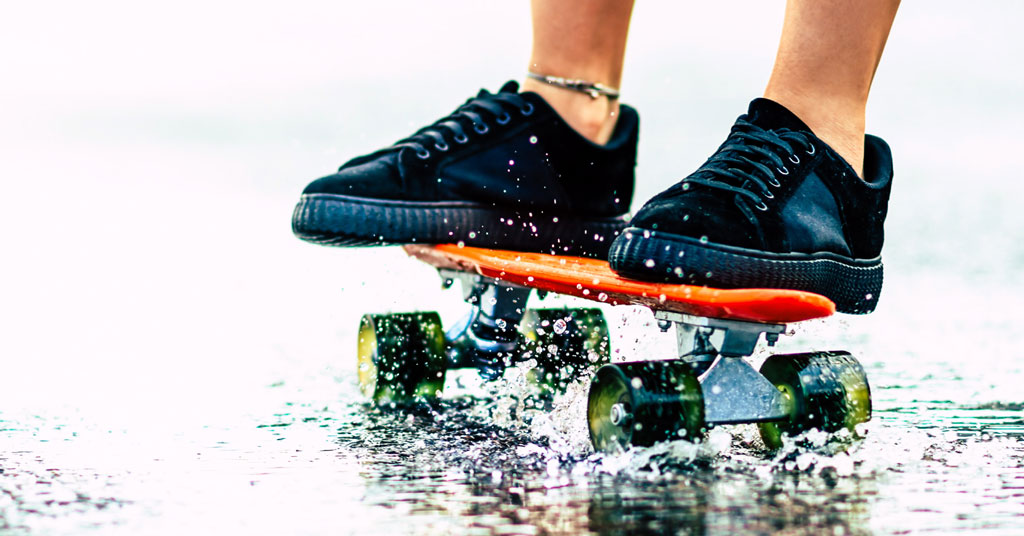By Vincent Liew

Yes!
Let’s start off on the right foot — or the left foot, if you’re left-handed. It’s good to set the record straight. Skateboards can get wet. When and how they get wet can determine whether they are damaged by water. For example, riding a skateboard in the rain is not the same as submerging it in water, which is again different than leaving it out in the rain.
The Deck or Board
The deck of the skateboard is usually made of wood. When it comes in contact with water wood can become soft and deform. Even after it dries out, the board’s performance may not be as good as it was before getting wet. You may realize that the skateboard does not have a crisp pop to it any longer.
The Bearings and Bolts
When skateboards get wet, their bearings can lose their lubrication and the bolts can rust. When lubrication fails, the skateboard will slow down, and the bearings will start to weaken from the inside out. The skateboard will not move as fast or as smoothly as you have come to expect. As water gets below the surface, it takes a long time for it to dry. This makes the bolts rust. Rusty bolts can lead to breakage, although the breakage will be a slow process, not a sudden one. Other parts of the skateboard to consider for the impact of water:
- Grip tape works well to give your feet traction on the board, even when wet. But grip tape can lose adhesion over time with repeated wetting and drying. If that happens, the tape will start to peel off the deck.
- Skateboard trucks can withstand water for some time, but if they get wet too frequently, they will soon start to rust.
- Made of synthetic hard rubber, skateboard wheels have absolutely no problem with getting wet.

After Wetting, What Next?
If your skateboard gets wet, there are some measures you can take to reduce the consequences that result. The most important thing to do is to take the skateboard away from the source of water and dry it. Some of the necessary things to do are:
- Remove the hardware in order to disconnect the deck from the trucks. You can then use a towel or a rag to dry the board, the hardware, the trucks and the grip tape.
- Remove the wheels, then dry the inner and outer parts of the bearings. Spray some lubricant on the bearings. Doing this will ensure that the bearings are protected from rusting.
- Put the deck in the sun for as long as you can to get it dry. If you have a bad weather, keep it inside a garage so it can air dry. To confirm if the skateboard is dry or not, tap on it and listen to the sound it makes. If you get a sound like the sound it makes when dry, then the skateboard is dry. Once this is achieved, reassemble the board and move on to enjoy skateboarding.
Start and Enjoy Skating
As much as possible, try to avoid getting your skateboard wet. Water is bad for the bearings, board, trucks and bolts. Plus, you might have to deal with hydroplaning, which could affect your ability to control the skateboard. So, try not to skate in the rain or through puddles. But if your skateboard does get wet at all, follow the steps above and you should be good to go.
But . . . what about your electric skateboard?
Can Electric Skateboards Get Wet?
Electric skateboards are a slightly different story. They have the same considerations as their non-powered counterparts: a deck, wheels, bearings, and bolts. But they also have a battery, motor and electronic components to consider.
An electric skateboard might advertise a certain level of water resistance, but that doesn’t mean it’s waterproof. Even boards that have high IP ratings run the risk of damaged electrical and drive systems after repeated or prolonged exposure to wet conditions. If board malfunctions occur, there’s a higher-than-normal chance of serious injury. After riding in wet conditions, electric skateboards should always be wiped down and dried out.
In the end, trust your instincts. Some people have ridden in the rain and their boards were just fine. Others have ended up with a wrecked board. Always check for the IP rating of an electric skateboard and use our guide.